Marine Electronics Market Size and Forecast 2025 to 2034
The global marine electronics market size was estimated at USD 6.80 billion in 2024 and is predicted to increase from USD 7.24 billion in 2025 to approximately USD 12.78 billion by 2034, expanding at a CAGR of 6.51% from 2025 to 2034. The increasing maritime activities globally are driving the growth of the market. A lot of goods/products are imported and exported via marine routes, which is why marine electronics are required.
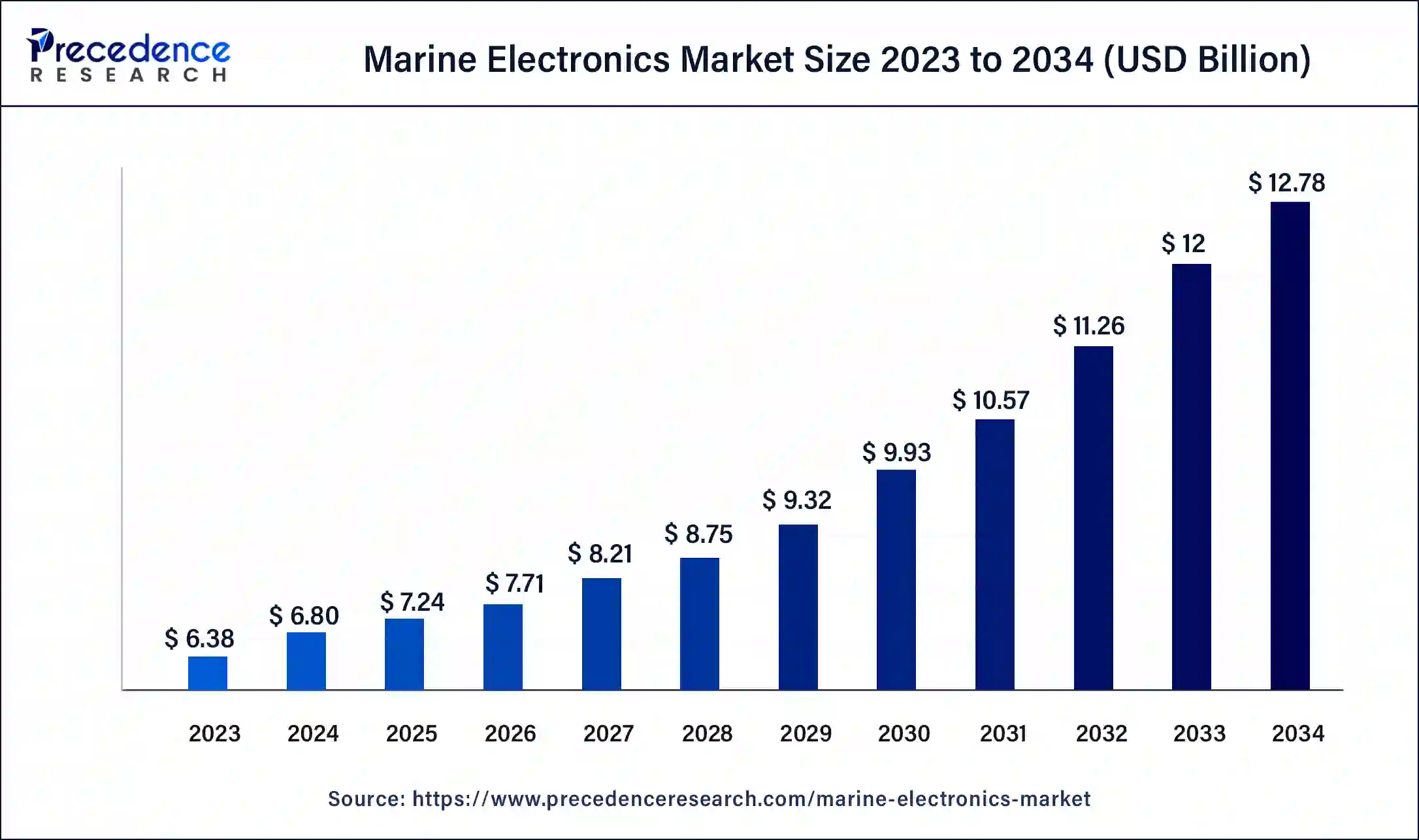
Marine Electronics Market Key Takeaways
- In terms of revenue, the marine electronics market is valued at $7.24 billion in 2025.
- It is projected to reach $12.78 billion by 2034.
- The marine electronics market is expected to grow at a CAGR of 6.51% from 2025 to 2034.
- North America dominated the marine electronics market with the largest market share of 38% in 2024.
- Asia Pacific is expected to grow at a solid CAGR of 7.42% during the forecast period.
- By component, the hardware segment contributed more than 71% in 2024.
- By component, the software segment is expected to expand at a CAGR of 7.42% during the predicted period.
- By vessel type, the merchant vessel segment generated more than 48% of market share in 2024.
- By vessel type, the recreational boats segment is projected to grow at a notable CAGR of 7.12% during the forecast period.
- By application, the navigation system segment captured the biggest market share of 45% in 2024.
- By application, the entertainment system is expected to grow at a remarkable CAGR of 7.12% during the forecast period.
How Can AI Impact the Marine Electronics Market?
The adoption of AI in the maritime industry is driving transportation in its several essential applications, such as predictive maintenance, fleet management, cargo optimization, risk management, and supply chain management. The adoption of artificial intelligence (AI) in the maritime has improved profitability and efficiency and reduced errors and environmental impacts of shipping. AI is an efficient technology that helps automate and digitize operations.
The AI could further help in navigation and route optimization, equipment and vessel maintenance, fuel consumption, port density, and traffic. AI could navigate and optimize the routes for the ships without human intervention, which drives the opportunities for the development of autonomous ships with limited crew members. It provides accurate decision-making in maritime activities. AI could improve the effectiveness of marine electronics with longer lifecycles and improved efficiency.
- In March 2024, Marine Insights, a globally recognized maritime information website, launched the MarineGPT; it is a revolutionary AI tool that is a monumental step towards cutting-edge assistance in answering queries related to maritime troubleshooting, maritime regulations, ship-specific assistance, and other queries.
U.S. Marine Electronics Market Size and Growth 2025 to 2034
The U.S. marine electronics market size was exhibited at USD 1.94 billion in 2024 and is projected to be worth around USD 3.71 billion by 2034, poised to grow at a CAGR of 6.70% from 2025 to 2034.
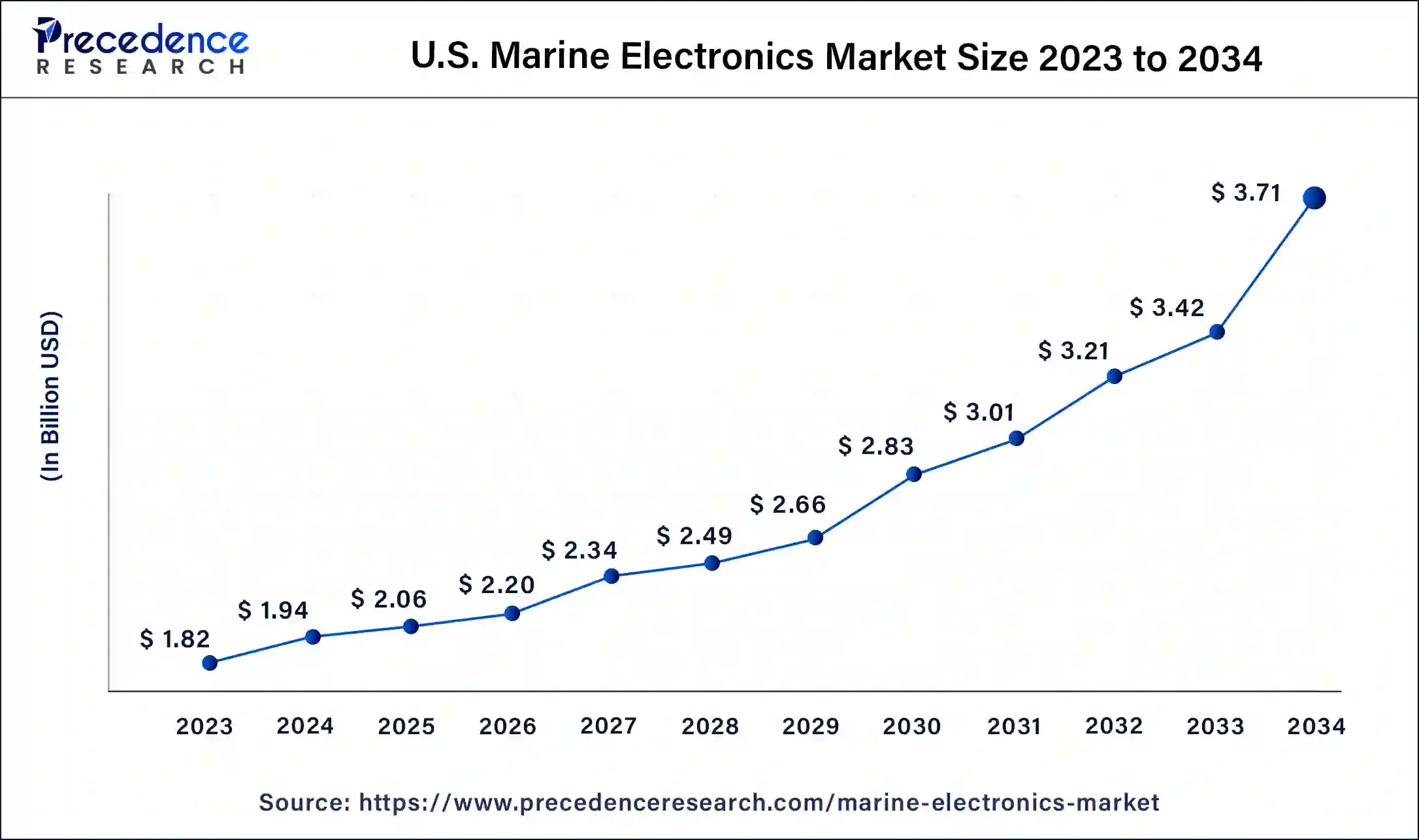
North America dominated the marine electronics market in 2024. The growth of the market is attributed to the rising development of marine infrastructure in terms of logistics and transportation, passenger segment, and other recreational areas. The rising disposable income and the shifting lifestyle standards are driving marine activities in rental, buying, or leasing passenger vessels for vacation, and the increasing number of marine passengers are driving the passenger vessels and the developed industrial infrastructure in regional countries like the United States, and Canada is boosting the intercontinental logistics and transportation of goods are driving the growth of the marine shipping activities that further fuel the growth of the marine electronics market across the region.
- In August 2024, the U.S. Bureau of Economic Analysis and the U.S. Census Bureau announced that the deficit of goods and services was $73.1 billion in June, down $1.9 billion from $75.0 billion in May.
- The balance of exports and imports in June was $265.9 billion, $3.9 billion more than May exports. The imports in June were $339.0 billion, $2.0 billion more than the imports in May.
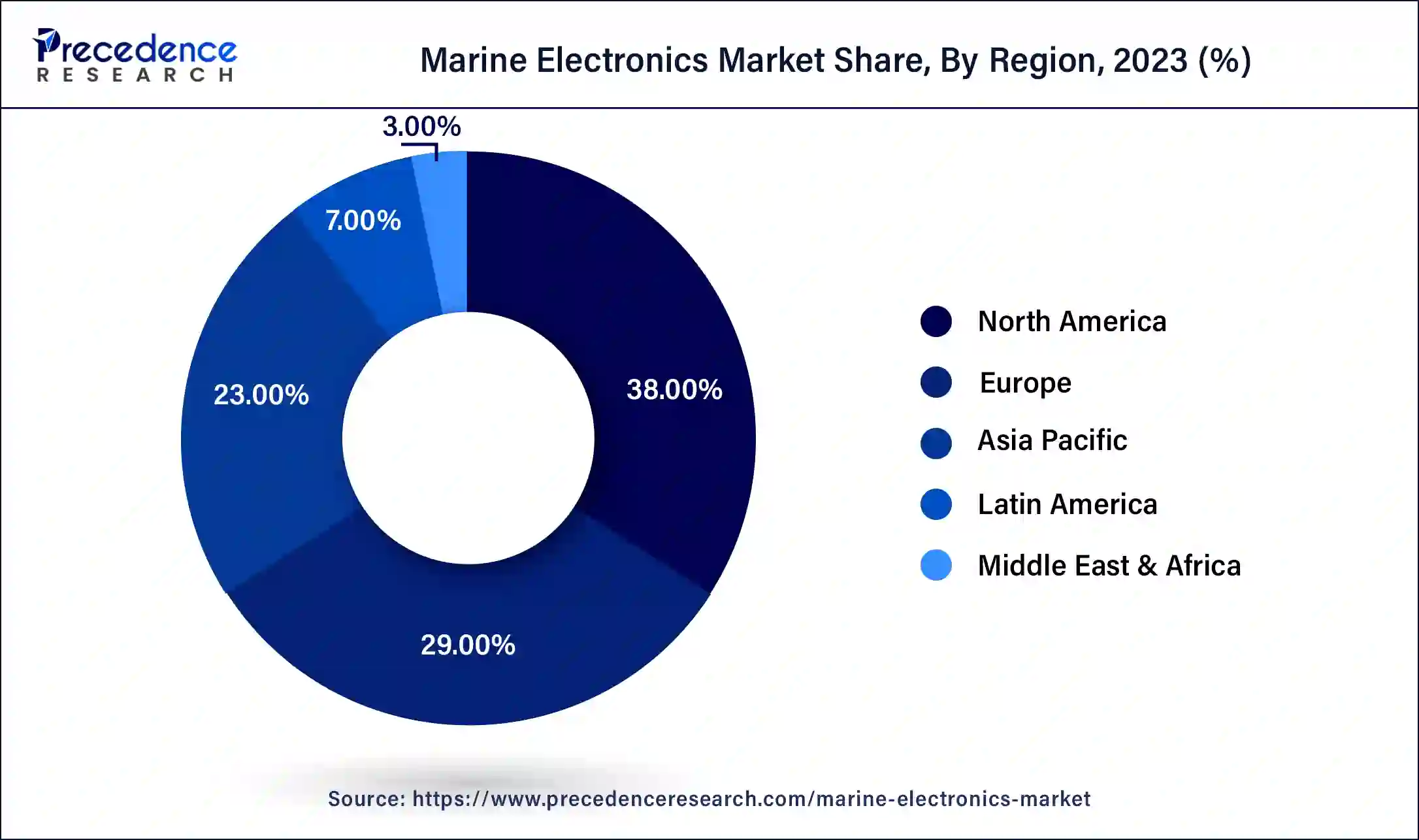
Asia Pacific is expected to have the fastest growth during the forecast period. The growth of the market is owing to the higher availability of ports in the regional countries, and the increasing import and export activities by the seaways are driving the growth of marine electronics. Additionally, the rising maritime activities for fishing and other commercial activities are driving the growth of the marine electronics market in the region.
- India accounted with the number of fleet is 1526 vessels with 13.75 million gross tonnage (GT) in 2023, comparing the fleet strength of 1520 vessels with 13.69 million GT in 2022.
- As of 31st December 2023, from the total 1526 vessels, 68% are engaged in coastal trade, and 32% are engaged in overseas trade.
Market Overview
Marine electronics are the specialized electronic devices that are made for use in marine activities or marine vehicles such as yachts, boats, and ships; they are generally water-resistive and waterproof and do not destroy the saline water of oceans or seas. The marine electronic generally includes the marine VHF radio, chart plotter, fishfinder, self-steering gear, marine radar, sonar, satellite navigation devices, satellite television, fiber optic gyrocompass, and marine fuel management. The increasing maritime activities such as shipping and transportation, passenger vessels, and the generation of energy from offshore are driving the growth of the marine electronics market.
Marine Electronics Market Growth Factors
- The rise in maritime activities such as transportation, logistics, fishing, passenger, and other commercial maritime activities is driving the demand for efficient marine electronics for safer management, which further boosts the growth of the marine electronics market.
- The rising implementation of advanced technologies in marine electronics, such as IoT (Internet of Things), sensors, artificial intelligence, and other advancements, to increase efficiency in navigation, communication, and safety management of ships or other marine boats or vessels are contributing to the robust growth in the marine electronics market.
- The increasing offshore energy generation activities, such as the production of gases, oil, and renewable energy, are driving the demand for specialized electronic equipment that can handle and work in water bodies.
- The rising advancements in marine ships or vessels, with advanced digitization and automation that enhance the comfort, safety, and speed of the vessels or boats, create the demand for the market.
- The rising demand for real-time navigation, communication, and entertainment systems in vessels and the investment in the development of satellite-based cellular communication systems in marine are driving the marine electronics market's growth.
Marine Electronics Market Trends
- In August 2024, Honeywell launched the Emissions Management Suite, which is now Hazardous Location (HazLoc) and marine certified, the sector's first end-to-end solution for offshore oil and gas assets to monitor, measure, report, and minimize emissions.
- In July 2024, Briggs Marine launched Freire Shipyard, a new maintenance support solution at the Vigo.
Key Factors Influencing Future Market Trends
- Expansion of the recreational boating sector: The global recreational boating industry is experiencing increased expansion due to higher disposable incomes and interest in outdoor activity. Such activities as cruising, sailing, and fishing gain popularity among the demographics and increase the demand for technologically-armed ships, and contribute greatly to the marine electronics market increase.
- Technological advancements enhancing navigation:Recreational boating has been revolutionised by modern marine electronics, bringing cutting-edge navigation tools. Some of the devices that provide real-time navigation information, such as positioning and route planning, as well as weather conditions, are GPS chartplotters, multifunction displays (MFDs), and electronic navigation charts (ENCs), and therefore, contribute to increased security, accuracy, and comfort in maritime activities.
- Convergence of smart entertainment and connectivity:The combination of communication systems, onboard Wi-Fi, as well as entertainment technology has taken recreational boating experience to a new level. With satellite communications, multimedia streaming, and Smart vessel monitoring, boaters are set for comfort, connectivity, and control in their marine electronics, and as such, marine electronics is a key part of the innovations in the leisure boating world.
Market Scope
| Report Coverage | Details |
| Market Size by 2034 | USD 12.78 Billion |
| Market Size in 2025 | USD 7.24 Billion |
| Market Size in 2024 | USD 6.8 Billion |
| Market Growth Rate from 2025 to 2034 | CAGR of 6.51% |
| Largest Market | North America |
| Base Year | 2024 |
| Forecast Period | 2025 to 2034 |
| Segments Covered | Component, Vessel Type, Application, and Regions |
| Regions Covered | North America, Europe, Asia-Pacific, Latin America and Middle East & Africa |
Market Dynamics
Driver
The increasing maritime activities driving the growth of the market
The rising maritime activities, such as transportation and shipment of goods and products, as well as the rise in import and export activities via water bodies, are driving the growth of the maritime industry and are anticipated to drive the demand for marine electronics.
The rise in maritime activities drives the demand for efficient and effective electronic systems such as navigation, real-time communication, entertainment, and others, and the advancements in some marine electronics are autopilot or self-steering systems, compass, chart plotter, GPS systems, radar, and others. Additionally, the rising research and development activities in the launch of marine equipment and vessels with improved performance are driving the growth of the marine electronics market.
Restraint
High cost of technology
The increased cost of the development of marine electronics due to the higher cost of raw materials and technologies associated with the electronics are limiting the production of marine electronics and restraining the growth of the marine electronics market.
Opportunity
Rising development of offshore energy plants
The rising use and development of offshore or marine energy are driving the opportunity for growth in the marine electronics market. There is an increasing inclination towards natural resources for energy generation, such as oil and gas and electric energy. Marine electronics are designed for water-resistive properties and are not impacted by the ocean's saline water. The rising demand for a clean source of energy is driving the number of offshore energy or marine energy plants across various regions.
- 40% of the U.S. population lives in the coastal region and depends upon the vast amount of renewable energy resources. The tides and waves of the oceans create an enormous amount of energy that can be created for electricity; if all the marine energy can be captivated, it fulfills 60% of the annual demand for electricity.
Technological Advancement
The marine electronics market is growing at a rapid rate, driven by new technologies to improve on safety and efficacy of operations and sustainability in the maritime sector. Through the combination of artificial intelligence and predictive maintenance, with limited downtime and operation costs. Furthermore, digital transformation processes – including the adoption of the IoT and cloud-based solutions – make fleet management and compliance with environmental regulations more efficient. The increased focus on sustainable measures, such as fuel-efficient route planning as well as emission monitoring, continues to support market growth.
Component Insights
The hardware segment held the largest share of the marine electronics market in 2024. The rising prevalence of marine activities for security, defense, commercial activities, shipping, and entertainment. The rising demand for efficient navigation and technologies in marine activities is driving the demand for a number of hardware equipment such as VHF radios, marine cameras, chart plotters, beacons, navigation equipment, compass, fish finders, fuel monitoring and management, fuse, GPS, marine publications, sensors, and switches, and switches panel. Additionally, ongoing investment in the development of new hardware components is driving the demand for the hardware segment.
The software segment is expected to have the fastest growth in the marine electronics market during the predicted period. The rising implementation of artificial intelligence, IoT, and sensors in the software for improving accuracy and advances maritime analytics and predictive maintenance solutions. The increasing demand for efficient and improved safety is driving the advanced technologies in the software segment. The rising digitization and automation in marine software are enhancing the efficiency and safety of marine equipment and electronics.
Vessel Type Insights
The merchant vessel segment dominated the marine electronics market in 2024. The increasing demand for the advancement in the navigation, safety, and communication system that drives the growth of the merchant vessel segment. The merchant vessel is also known as the merchant ship. Merchant vessel or merchant ship is a type of national commercial shipping. There are seven types of merchant vessels identified in the port, including bulk cargo ships, general cargo ships, chemical tanker ships, crude oil tanker ships, container ships, passenger/roro ships, and LNG tanker ships. The rising transportation and shipping activities via water bodies or marine are driving the demand for the merchant vessel segment.
- In January 2023, the global merchant fleet includes of 105 500 vessels of 100 gross tons (gt), of which 56 500 ships were over 1000 gt. In 2022, in terms of shipbuilding tonnage, 93% of the shipbuilding was completed in China, Japan, and the Republic of Korea.
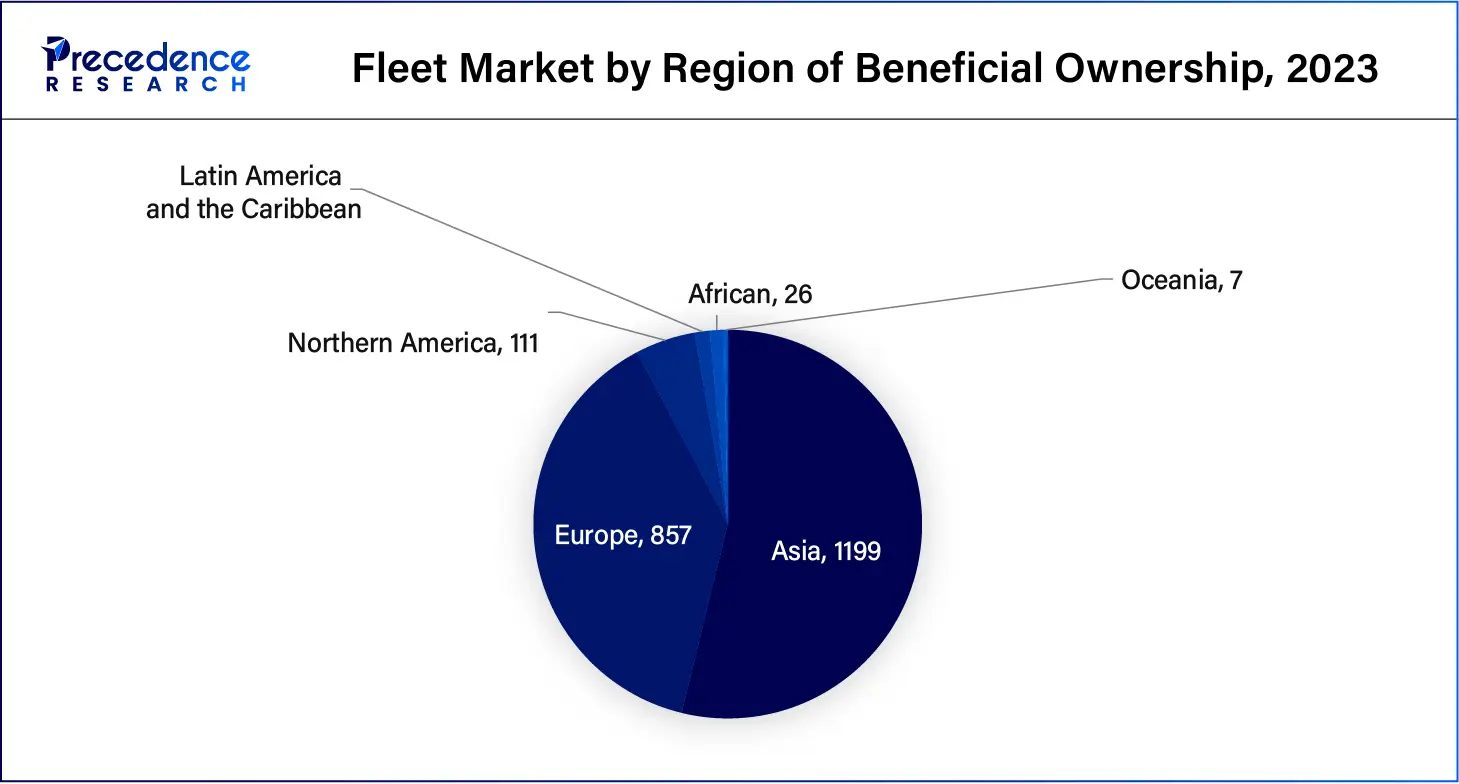
- More than half of the fleet tonnage is occupied by Asian companies; European owners occupied 38%, and Northern American companies accounted for 5%.
The recreational boats segment is projected to grow at the fastest CAGR in the market during the forecast period. The recreation boats are also known as passenger vessels and small passenger vessels. The recreational boats are manufactured for rental, leased, and chartered and are majorly used for pleasure or entertainment. There are different types of recreational boats: airboats, bow rider boats, cabin cruisers, canoes, catamarans, dolls, personal watercraft, deck boats, fishing boats, and pontoon boats. The increasing demand for recreational boats for entertainment, luxury, and fishing purposes drives the growth of the recreational boats segment.
Application Insights
The navigation system segment captured the largest share of the marine electronics market in 2024. Marine navigation is one of the important applications in marine electronics, such as ships, boats, and others. Marine navigation is the efficient combination of software, equipment, and tools that provide the precise and accurate determination of location, chart courses, and safer navigation through the water. Marine navigation is an effective system for reducing latency and collision and ensures efficient voyages. There are some of the leading marine navigation systems currently operated by major marine shipments are as follows:
- Standard Horizon GX2200 Matrix AIS/GPS
- Maretron N2KView Vessel Monitoring System
- B&G Zeus3 S Multifunction Display
- Simrad NSO evo3S
- Transas Navi-Sailor 4000 ECDIS
- Furuno NavNet TZtouch3
- Raymarine Axiom Pro Series
- Garmin GPSMAP Series
- Wärtsilä SAM Electronics NACOS Platinum Series
- Navico Broadband 4G Radar
- Kongsberg K-Bridge Integrated Navigation System
- MaxSea TimeZero Marine Navigation Software
- Nobeltec TimeZero Professional
- JRC JAN-9201/7201 ECDIS
- Northrop Grumman Sperry Marine VisionMaster FT
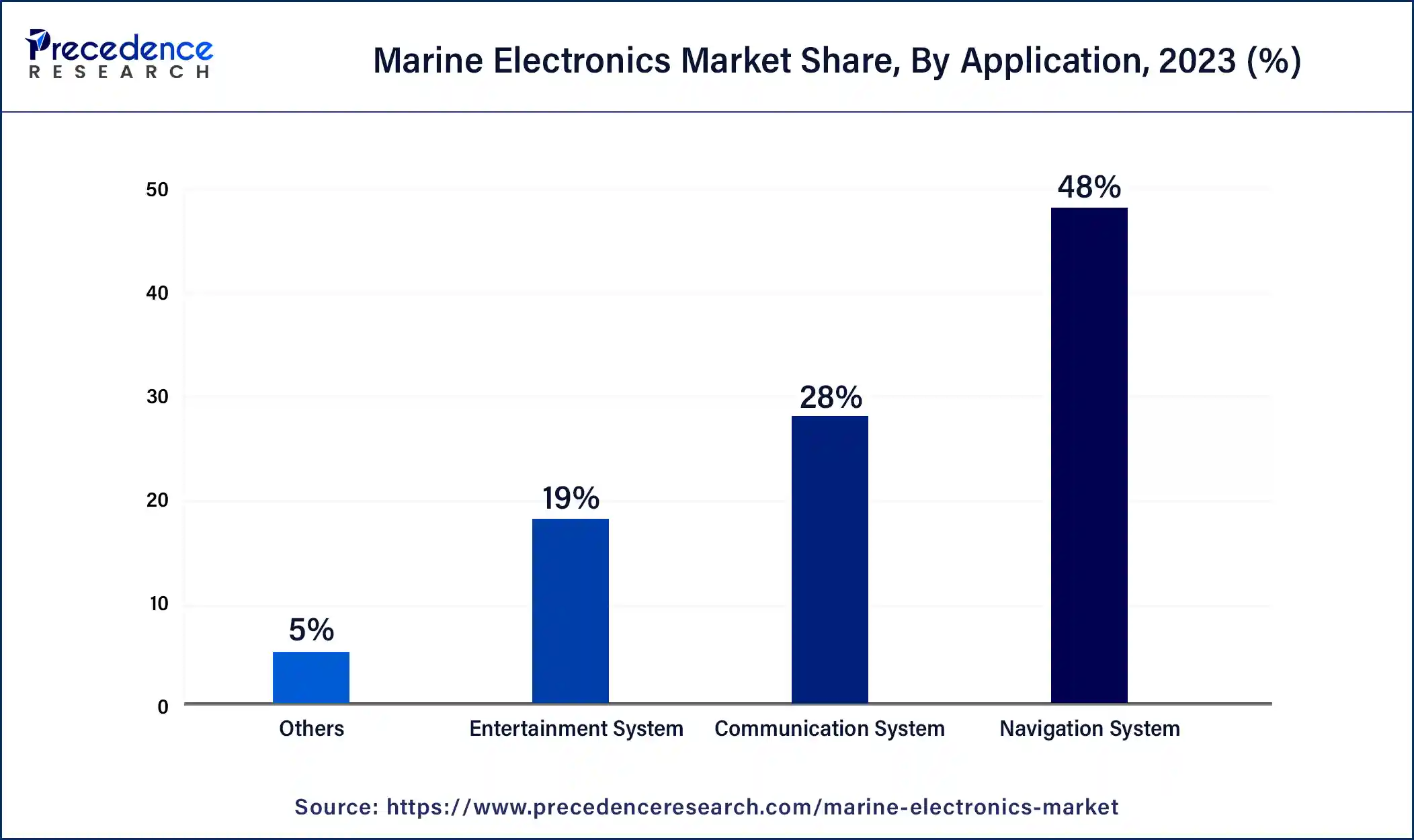
The entertainment system segment is expected to grow at the fastest rate in the marine electronics market during the forecast period. The rising passenger traffic in marine ships is due to the rising disposable income and the rising adoption of the luxurious lifestyle. The rising demand for technological advances and luxurious entertainment options in the ships, such as audio, video, and other connectivity solutions with enhanced performance, is driving demand for the entertainment systems in the vessels or ships that contributed to the growing demand for the entertainment system segment.
Marine Electronics Market Companies
- Northrop Grumman
- Wärtsilä
- Thales
- Tokyo Keiki.
- L3Harris Technologies, Inc.
- Japan Radio Co., Ltd.
- Teledyne FLIR LLC
- ATLAS ELEKTRONIK GmbH
- Garmin Ltd.
- Furuno Electric Co., Ltd.
- Kongsberg Maritime
- Navico Group
Recent Developments
- In July 2024, Garmin, a marine electronics manufacturer, was selected as the exclusive supplier of marine electronics and audio solutions for Independent Boat Builders, Inc. (IBBI) from model year 2025 through model year 2029. This brand agreement covers Garmin's full range of products, including, but not limited to, chart plotters, navigation systems, trolling motors, stereos, and speakers. IBBI represents a cooperative group of 15 leading boat brands in the U.S, collectively representing over 25% of the U.S. boats built.
- In July 2024, Cobham Satcom launched the latest antenna ‘Sea Tel 370s TV is Cobham Satcom's second new TVRO' specially designed for the mega yachts and cruise ships for the maritime market.
- In May 2024, Raymarine, a leading player in the high-performance marine electronics for the marine first responder, recreational boating, and law enforcement markets, launched the NorthCoast Boats' flagship 415HT and delivered the full suite of electronics.
Segments Covered in the Report
By Component
- Hardware
- Software
- Services
By Vessel Type
- Merchant Vessels
- Fishing Vessels
- Recreational Boats
- Others
By Application
- Navigation System
- Communication System
- Entertainment System
- Others
By Geography
- North America
- Asia Pacific
- Europe
- Latin America
- Middle East & Africa
For inquiries regarding discounts, bulk purchases, or customization requests, please contact us at sales@precedenceresearch.com
Frequently Asked Questions
Ask For Sample
No cookie-cutter, only authentic analysis – take the 1st step to become a Precedence Research client
 sales@precedenceresearch.com
sales@precedenceresearch.com
 +1 804-441-9344
+1 804-441-9344